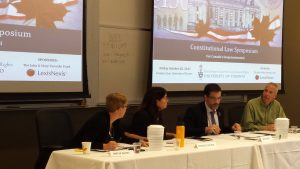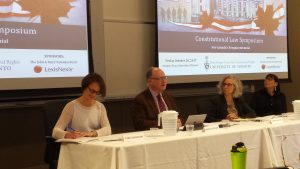By Catherine Ma
Asper Centre Constitutional Law Symposium, Panel III: Outside the Four Corners of the Charter
The afternoon panel of the Asper Centre’s October 20th 2017 Constitutional Law Symposium for Canada’s Sesquicentennial, titled Outside the Four Corners of the Charter, included papers that reflected on the development of Canadian constitutional law beyond the Charter. The panel featured Eric Adams, an associate Professor at the University of Alberta, Faculty of Law; Professor Richard Stacey from the University of Toronto, Faculty of Law; and University of Toronto Law Professor David Schneiderman. The panelists’ respective papers explored the Bill of Rights, the duty to consult Indigenous Peoples, and unwritten constitutional principles. Professor Lorraine Weinrib from the University of Toronto, Faculty of Law moderated.
Professor Adams began the session by presenting his paper, entitled “Writing Rights: the Canadian Bill of Rights in Canadian Constitutional History” and arguing that the Bill of Rights holds an important – and often overlooked – place in constitutional law. He acknowledged that the Bill of Rights largely lacks jurisprudential value, as the Supreme Court of Canada has rejected most legal arguments invoking the Bill. Further, in the only case where the Bill of Rights was successfully argued, R v. Drybones, the SCC expressly said that the Bill of Rights only renders legislation inoperative, if the legislation subjected groups to harsher treatment on its prohibited grounds. Drybones is also notable for the dissent by Cartwright CJ, who stressed that the Bill of Rights does not permit courts to invalidate laws in conflict with the Bill – an assertion that is diametrically opposed to his earlier statements in other Bill of Rights cases. Despite admitting these limitations, Professor Adams declared that the Bill of Rights is important for changing public “imagination” and dialogue around constitutional law, which ultimately enabled the Charter of Rights and Freedoms to arise.
Professor Stacey, drawing from his paper entitled “Honour and Sovereignty: How Democratic Accountability Shapes the Duty to Consult Indigenous Peoples” questioned the extent to which the Crown can delegate its duty of consult Indigenous Peoples. He noted that in Haida Nation, the SCC stated that the Crown may delegate procedural aspects of consultation to industry proponents seeking a particular development. This statement makes “no sense” since the Crown effectively would be delegating its duty to consult Indigenous Peoples to the industries whose work is undermining Indigenous rights. So, would the Crown need to be involved in consultations between Indigenous Peoples and industry proponents? If so, how much Crown involvement would be required? Professor Stacey answered his own questions by situating the duty to consult in a broad understanding of reconciliation. For him, reconciliation means harmonizing two “paradoxically opposed” perspectives: The belief that Canada has enjoyed sovereignty over Indigenous Peoples since Confederation, and the view that many Indigenous Peoples never surrendered their sovereignty to the Canadian state. This conception of reconciliation suggests s. 35 of the Constitution Act, 1982 should be a framework to restore self-determination to Indigenous Nations – and guarantee Indigenous Peoples’ meaningful participation in decisions affecting them.
Professor Schneiderman in his presentation titled “Unwritten Constitutional Principles in Canada: Genuine or Strategic?” contended that the SCC acts strategically when invoking unwritten constitutional principles in its decisions. He elaborated the SCC does not intend for unwritten constitutional principles to guide jurisprudence in constitutional law; rather, the SCC appeals to these principles in order to “get out of a jam” and “escape from its legitimacy problem.” In Reference Re: Secession of Quebec, the SCC applied the principles of federalism, democracy, constitutionalism and the rule of law, and protection of minorities in order to disavow unilateral secession and found a constitutional duty to negotiate when a province wishes to secede from Canada. Yet, in BC v. Imperial Tobacco Canada Ltd., the SCC rejected appeals to the rule of law; and in Quebec v. Canada, the SCC similarly rejected the idea of cooperative federalism. This behaviour suggests that the SCC is acting rationally to secure their desired objectives.
The audience was interested in the nuances of the panelists’ arguments. They questioned if public imagination influenced the Bill of Rights – or if only the Bill shaped public opinion, other ways that sovereignty might manifest for Indigenous Peoples, and whether unwritten unconstitutional principles have strength due to their actual content or the fact that these principles are unwritten. Other questions linked ideas from the different papers together. Such questions included: Is the Honour of the Crown an unwritten constitutional principle that guides s. 35 jurisprudence?
Catherine Ma is a 2L JD Candidate at the Faculty of Law and is also a co-leader of the Asper Centre’s Indigenous Rights student working group.


